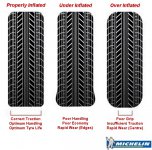Is it better to be over-inflated or under-inflated?
Obviously it's better to be spot on, but how do you know if you are?
If you inflate to the pressure stated in the handbook, and you are sure the pressures in the tyres are correct, how do you know the pressures are correct for your new tyres when they are a different make (but same size) to the originals?
Different tyres need different pressures?
To be honest, I don't know with regard to car tyres, but I do know with respect to bicycle tyres. Same bike with same size tyres but different makes state different pressures. It's all to do with design.
Mick.
So 32 front and 30 rear? Regardless of whether it’s a bike, a truck, a Fiat 500, a 3 series estate or a Porsche 911?
Pressures are like torque figures, sure, exact is best, but near enough is also going to be safe enough. My rears should be 46 PSI when my car is fully laden on summer tyres. If my gauge is 10% out, then the pressures could be 41.4 PSI which is still going to be safe, or they could be 54.4 PSI which is going to be fine as well.
But if I set the rears wrong in the first place, to say 30 PSI, then they could be as low as 27 PSI which is probably not going to be safe and I run a greater risk of rolling a tyre off a rim or getting a sudden loss of total pressure at speed which could be fatal.
That’s why arbitrary figures are a terrible idea, they could end up with someone being killed.


